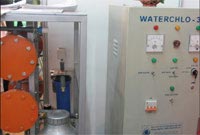At small water supply stations in various locations, water is disinfected using gas or liquid chlorine. This traditional method does not control concentration effectively and can leave harmful residual chlorine for users. The High Technology Development Center (Vietnam Academy of Science and Technology) has proposed a new solution – disinfection using Javel water produced on-site from salt.
 |
|
The waterchlo system, a device for producing Javel water from saltwater. (Photo: B.H.) |
To meet the standards set by the Ministry of Health, drinking water must be disinfected at the final stage before being supplied to households. Large factories carry out this process by injecting gas chlorine. However, this substance is highly toxic and unsafe for transportation and storage, making it unsuitable for small-scale water supply stations.
Another solution is chlorine powder. However, manually mixing the powder into water poses health risks to workers and can contaminate the water station. Additionally, this powder absorbs moisture and releases chlorine gas, leading to rapid quality degradation during storage. A more viable solution is Javel water (sodium hypochlorite). It is effective for disinfection and easy to transport, but it has a high cost and degrades quickly during storage and transportation, potentially reverting to regular water.
Water can also be disinfected using ozone or ultraviolet rays; however, since these methods only provide immediate disinfection, they are not suitable for water that must continue flowing through pipes and storage tanks after treatment.
The research team at the High Technology Development Center, Vietnam Institute of Materials Science – Vietnam Academy of Science and Technology, has proposed a solution that is a first in the country: electrolyzing saltwater to produce Javel water on-site (or electrolyzed sodium hypochlorite).
Dr. Nguyen Dinh Cuong, the project leader, stated that in this form, Javel is a strong oxidant that is non-toxic and does not degrade like commercially available Javel water. It allows for on-demand production, eliminating the need for long-distance transportation required by other methods. This makes it highly effective for disinfecting water on a medium and small scale.
Based on this principle, the research team has successfully designed and manufactured devices that produce Javel water suitable for various scales ranging from 10 to 1000 cubic meters per hour. The device will be integrated into the water supply cycle, using only electricity, water, and salt as input materials. The output of the device is electrolyzed Javel water, which is introduced into the water pipeline at a specific ratio. With this method, disinfecting 1 cubic meter of drinking water costs only 25 dong, significantly cheaper than other methods. Additionally, operators can easily adjust the concentration of Javel water in the pipeline as desired.
Mr. Cuong also mentioned that the machine has features comparable to American equipment but costs only one-third of the price. Due to these many advantages, the device, which has only been introduced since late 2005, has already been embraced by many localities, including six units for a clean water project in Nghe An. Mr. Cuong noted that the product is the culmination of ten years of research at the Center.
Contact: High Technology Development Center, Vietnam Academy of Science and Technology. House A25-18 Hoang Quoc Viet, Cau Giay, Hanoi. Tel: 04 – 8364152. Fax: 04-7561352. Le Dung – 0912069443.
T. An
















































